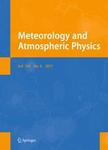版权所有:内蒙古大学图书馆 技术提供:维普资讯• 智图
内蒙古自治区呼和浩特市赛罕区大学西街235号 邮编: 010021

作者机构:Indian Inst Trop Meteorol Pune 411008 Maharashtra India Stockholm Univ Dept Environm Sci & Analyt Chem ACES S-10691 Stockholm Sweden Savitribai Phule Pune Univ Dept Geol Pune 411007 Maharashtra India
出 版 物:《METEOROLOGY AND ATMOSPHERIC PHYSICS》 (气象学和大气物理学)
年 卷 期:2019年第131卷第5期
页 面:1497-1508页
核心收录:
学科分类:07[理学] 070601[理学-气象学] 0706[理学-大气科学]
基 金:Indian Institute
主 题:Aerosols Organic carbon Meteorological parameters Gravimetry Biomass burning Anthropogenic factors Human influences Principal components analysis Chemical speciation Organic chemistry Burning Incineration Mass Particulate matter Abundance Species Biofuels
摘 要:The major water-soluble ions, organic carbon (OC), elemental carbon (EC) and mass concentration of fine- (PM2.5) and coarse-mode (PM10-2.5) aerosols were measured at Pune during January-December 2016. The mass closure approach was used by comparing the sum of the masses of the individual chemical species to the gravimetric PM obtained by weighting the filter samples. The 1 year mean total mass concentration of fine and coarse mode was 40 mu gm(-3) (64%) and 23 mu g m(-3) (36%), respectively. The PM2.5/PM10 ratio was 0.64 +/- 0.9 indicating an abundance of fine-mode particles over Pune during the study period. A principal component analysis identified three components, where the one with highest explanatory power (59%) displayed clear impact of anthropogenic sources on the measured mass concentration of a majority of the compounds. The strong linear relationships between EC, OC, nss-SO42- and nss-K+ suggest a predominance of a common primary source, with a contribution from biofuel as well as biomass burning sources. Keeping the strong correlation and sources of individual chemical species as the base, it was noticed that (1) major contributors to fine- and coarse-mode particles over the Pune regions are carbonaceous aerosols and secondary inorganic aerosols (non-sea-salt SO42-, NO3-, and NH4+), (2) anthropogenic aerosols contribute mostly to the fine-mode, and (3) meteorological parameters play an important role in controlling levels of fine- and coarse-mode particles. Taken together, the study clearly indicates the dominance of anthropogenic sources during the entire year with more significance in the winter season.